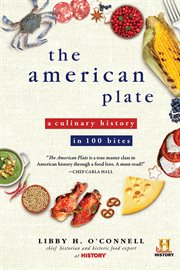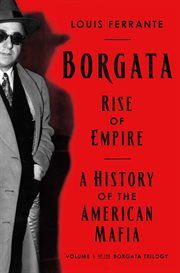The American plate A culinary history in 100 bites
eBook - 2014
From the chief historian at HISTORY® comes a rich chronicle of the evolution of American cuisine and culture, from before Columbus's arrival to today. Did you know that the first graham crackers were designed to reduce sexual desire? Or that Americans have tried fad diets for almost two hundred years? Why do we say things like 'buck' for a dollar and 'living high on the hog'? How have economics, technology, and social movements changed our tastes? Uncover these and other fascinating aspects of American food traditions in The American Plate. Dr. Libby H. O'Connell takes readers on a mouth-watering journey through America's culinary evolution into the vibrant array of foods we savor today. In 100 tantalizin...g bites, ranging from blueberries and bagels to peanut butter, hard cider, and Cracker Jack, O'Connell reveals the astonishing ways that cultures and individuals have shaped our national diet and continue to influence how we cook and eat. Peppered throughout with recipes, photos, and tidbits on dozens of foods, from the surprising origins of Hershey Bars to the strange delicacies our ancestors enjoyed, such as roast turtle and grilled beaver tail. Inspiring and intensely satisfying, The American Plate shows how we can use the tastes of our shared past to transform our future.
- Subjects
- Genres
- Cookbooks
- Published
-
[United States] :
Sourcebooks Inc
2014.
- Language
- English
- Corporate Author
- Main Author
- Corporate Author
- Online Access
- Instantly available on hoopla.
Cover image - Physical Description
- 1 online resource
- Format
- Mode of access: World Wide Web.
- ISBN
- 9781492603030
- Access
- AVAILABLE FOR USE ONLY BY IOWA CITY AND RESIDENTS OF THE CONTRACTING GOVERNMENTS OF JOHNSON COUNTY, UNIVERSITY HEIGHTS, HILLS, AND LONE TREE (IA).
Introduction Imagine, for a minute, traveling to a foreign country and exploring that nation's culture. How might you hope to really understand the people-their traditions, their customs, and the flavors of their cuisine? You might visit museums, walk down city streets, or browse country markets. You would definitely eat the food there, because that is one of the best and often most surprising ways to learn about a different place. In some respects, the past is another country as well. It has flavors of its own that are well worth exploring. Experiencing those tastes reveals a time when the people and places of our own country were radically different than they are today. Like time travelers, we can see what life was like for our predecessors by conjuring up the techniques, textures, smells, and tastes of America from two hundred, three hundred, and even four hundred years ago. The remarkable changes in ingredients, recipes, and menus over the centuries provide a window for us to appreciate just how different life has been during the various eras of America's story. Exploring our food heritage can also heighten our sense of the differences and similarities between then and now. For example, beaver tail is likely too gamey and fatty for our modern palates, but hungry fur trappers in the colonial period dined on it happily. Conversely, warm pumpkin pudding with heavy cream still appeals to us today, just as it enticed new colonists in seventeenth-century Massachusetts. So while this book is primarily about the evolution of America's national cuisine and "foodways"-a term that includes growing, harvesting, preserving, preparing, cooking, and eating food-history provides the context for understanding the intersection of culture and cuisine. The American Plate provides a multilayered overview of the peopling of our country, our evolving foodways, and the transformation of our palates from 1400 to today. American Indians, Anglo-American women, enslaved (and free) African Americans, Chinese, Japanese, and Indian immigrants, western and eastern European arrivals, Hispanic families, and many more have contributed the flavors of their cultures to help create the variety of international and local influences we find in modern-day American restaurants, grocery stores, and kitchen tables. To understand how America's diverse, edible heritage developed, it's worth exploring the people and events that shaped our cuisine and left indelible marks on the foods we savor today. Where did the raw ingredients for what we think of as American food originate? Were all foods local and seasonal before the introduction of modern transportation and preservation technologies? Who cooked the food, and whose culture predominated in the kitchen? These are just a few of the many questions we'll explore in these pages. This book serves as a guide to introduce you to both an America of long ago and a more recent and familiar one, through more than one hundred different foods (or Bites) organized by ten eras of our national history. Drawing from a variety of sources, the book aims to shed light on the myriad cultures, values, and traditions that make up the United States through stories about our food (some very short, some longer). Peppered throughout are anecdotes, images, and recipes for all sorts of American dishes-from roast beaver tail and succotash to mint juleps, shoo fly pie, and firehouse chili. Each chapter and each Bite stands alone, so you may read this book from front to back or just start with a time period or specific food that interests you. I chose certain foods because they and their history provide a particularly clear lens through which to view our broader national history. Others exemplify or are symbolic of a specific event, such as a version of a WPA soup recipe from the Great Depression. My hope is that these narratives and recipes will inspire readers to explore America's diverse culinary heritage, whether by recreating the unfamiliar tastes of the past or simply enjoying the stories I've included here. Throughout America's history, nature, economics, technology, and immigration have played important roles in our adaptation of indigenous foods, development of new ones, and adoption of others from different continents. Ultimately, by learning about the origins of our richly diverse culinary heritage and exploring the history of the foodways included in this book, we can develop a deeper understanding of how we became the curious and passionate eaters we are today.



